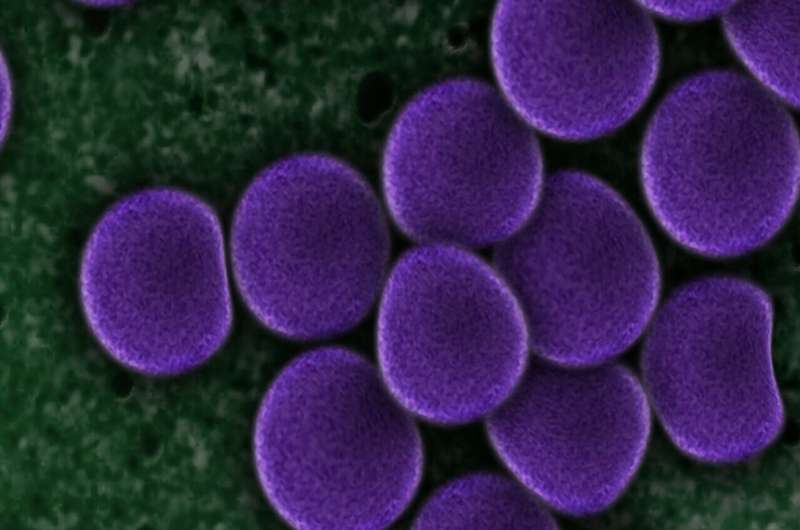This article has been reviewed according to Science X's editorial process and policies. Editors have highlighted the following attributes while ensuring the content's credibility:
fact-checked
peer-reviewed publication
trusted source
proofread
New model allows for learning and prediction of microbial interactions

A tiny but prolific world of microbes encompasses everything around us, both inside and out. Microbiomes, which are comprised of diverse communities of microbes, play a pivotal role in shaping human health, yet the intricacies of how different microbial compositions influence our well-being remain largely unknown.
In a recent study published in Proceedings of the National Academy of Sciences, researchers at the University of Illinois Urbana-Champaign describe a new framework they have created to predict how species within microbiomes interact with each other to create unique compositions.
"Microbes can be used in medicine, aka 'bugs as drugs,' and these microbial therapeutics hold the possibility of being the answer to many of the diseases we face today," said Shreya Arya, a graduate student in the O'Dwyer lab.
"We're trying to get away from using antibiotics to solve these issues because, over time, bacteria have developed antibiotic resistance. If the gut gets infected because of a pathogen, we want a way to be able to change the composition of the gut microbiome so that the gut microbiome is restored to a healthy state and the pathogen's abundance is suppressed."
Unfortunately, assessing interactions between each microbe species across diverse environments would demand an exponential volume of experimental data that would not be feasible to model. To overcome this hurdle, James O'Dwyer (CAIM), an associate professor of plant biology, along with Arya and Ashish George, a former postdoctoral researcher in O'Dwyer's lab, sought to create a model that could predict outcomes of microbial communities based on the microbes initially present at the start.
The model would provide a "landscape interaction value" between every microbe that essentially characterizes how much effect each of the microbes has on another's abundance and the microbiome's outcome.
"When doing this modeling, it's important to ask the right question," said O'Dwyer. "We could exhaustively try to model all of the pairwise comparisons and higher order interactions between species, which would give us the full dynamics of how the community changes over time, but that would literally take forever. Instead, we asked, at the end of all these microbial interactions, who's still there? How abundant are they, and then what are their functions in that end-point community?"
To address these questions, the research team started with a computational model capable of simulating microbial communities and predicting their outcomes. In this process, they uncovered a surprising revelation—most of the landscape interactions between microbes were near zero. This means that most microbes had a minimal impact on the final outcome of the microbiome, with only a select few playing a crucial role in predicting these outcomes.
The researchers then used a method from the field of signal detection called compressive sensing, which allows more information to be extracted from datasets with a sparse representation.
The model was trained using existing microbiome datasets, and the results of these interactions were verified through real-world experiments with the same microbiomes to see if the resulting interactions and composition matched the predictions. Intriguingly, the researchers found that the "sparsity," or abundance of zeros, of the landscape interactions held true, both in the model and in the real-world experiments.
"I think there's a lot we can learn about ecological communities in general from this," O'Dwyer said. "We often think there's all these complex interactions, and this leads the structure and community functions to be hard to predict. But this shows that sometimes the outcomes are a bit simpler than you might expect. The magic here is that you don't have to learn everything about every initial condition through to every final state. You just have to learn a bit of it, and it can give you enough information to know the whole thing."
The team is now interested in exploring why so many microbial landscape interactions were near zero and trying larger datasets to see if that changes the patterns they found.
"We want to understand why this sparsity is present in the first place if that can tell us something about how microbiomes fundamentally are assembled and how those species interact with each other," explained Arya. "For example, even though a soil microbiome has very different species taxonomically speaking compared to the human gut, there may be similarities in the ways that microbial species interact with each other that we can predict based on the environment."
Arya hopes to continue fine-tuning the model so that it can be used to study particular microbiomes of interest, and accommodate more diverse datasets. One ultimate goal is to be able to use the model in personalized medicine to help predict whether patients are at risk of certain pathogens establishing within their microbiomes compared to others.
"In order to create microbial therapeutics, we need to understand which microbial species we need to combine in which environments in order to get the best function. And this is a first step towards that goal," said Arya.
More information: Shreya Arya et al, Sparsity of higher-order landscape interactions enables learning and prediction for microbiomes, Proceedings of the National Academy of Sciences (2023). DOI: 10.1073/pnas.2307313120
Journal information: Proceedings of the National Academy of Sciences
Provided by University of Illinois at Urbana-Champaign





















